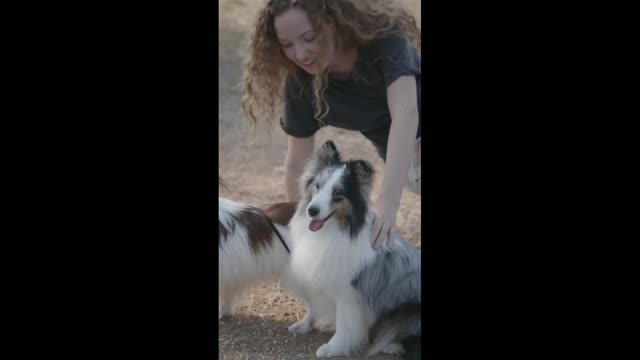Premium Only Content

THE TWO CUTE DOGS
FACTS ABOUT PUPPIES : -
Everyone loves puppies, we know. It's scientifically proven that they're heart-meltingly cute. But there's more to the little fur babies than just those adorable puppy eyes. In honor of National Puppy Day (which happens on March 23), here are 25 things everyone should know about these four-legged snuggle buddies.
1. THE WORD PUPPY HAS FRENCH ROOTS.
DAMEDEESO/ISTOCK VIA GETTY IMAGES PLUS
Etymologists think the term puppy may come from poupeé, a French word meaning doll or toy. The word puppy doesn't appear to have entered the English language until the late 16th century—before that, English speakers called baby dogs whelps. William Shakespeare's King John, believed to be written in the 1590s, is one of the earliest known works to use the (super cute) term puppy-dog.
2. PUPPIES EVOLVED TO BE BLIND AND DEAF AT BIRTH.
SVIATLANA BARCHAN/ISTOCK VIA GETTY IMAGES PLUS
Puppies are functionally blind and deaf at birth. On day one, their eyes are firmly shut and their ear canals closed. Why? In brief, it’s part of an evolutionary trade-off. Since pregnancy can hurt a carnivore's ability to chase down food, dogs evolved to have short gestation periods. Brief pregnancies meant that canine mothers wouldn't need to take prolonged breaks from hunting. However, because dog embryos spend such a short time in the womb (only two months or so), puppies aren't born fully developed—and neither are their eyes or ears.
3. PUPPIES HAVE BABY TEETH, TOO.
ERICLEFRANCAIS/ISTOCK VIA GETTY IMAGES PLUS
Like many newborn mammals, puppies are born completely toothless. At 2 to 4 weeks of age, a puppy's 28 baby teeth will start to come in. Around 12 to 16 weeks old, those baby teeth fall out, and by the time pups are 6 months old, they should be sporting a set of 42 adult teeth.
4. PUPPIES TAKE A LOT OF NAPS.
TETIANA GARKUSHA/ISTOCK VIA GETTY IMAGES PLUS
Like children, puppies need a lot of sleep—up to 15 to 20 hours of it a day. The American Kennel Club strongly advises dog owners to resist the urge to disturb napping puppies, because sleep is critical for a young canine's developing brain, muscles, and immune system. Puppy owners should also establish a designated sleeping space on their pup's behalf so they can snooze undisturbed.
5. CERTAIN DOG BREEDS ARE USUALLY BORN BY C-SECTION.
MIRASWONDERLAND/ISTOCK VIA GETTY IMAGES PLUS
Purebred dogs can exhibit some extreme bodily proportions, which doesn't always make for easy births. Breeds with atypically large heads are more likely to be born by C-section than those with smaller skulls. A 2010 survey of 22,005 individual dog litters in the UK found that terriers, bulldogs, and French bulldogs had Caesarian births more than 80 percent of the time. The other breeds with the highest rates of C-sections were Scottish terriers, miniature bull terriers, Dandie Dinmont terriers, mastiffs, German wirehaired pointers, Clumber spaniels, and Pekingeses, according to the study.
6. SOME DOG BREEDS HAVE BIGGER LITTERS THAN OTHERS.
ANASTASIIA CHERNIAVSKAIA/ISTOCK VIA GETTY IMAGES PLUS
As a general rule, smaller breeds tend to have smaller litters, while bigger dogs give birth to more puppies. The biggest litter on record was born to a Neapolitan mastiff that gave birth via Caesarian section to a batch of 24 puppies in Cambridgeshire, UK in 2004. In rare cases, very small dogs do give birth to relatively large litters, though. In 2011, a Chihuahua living in Carlisle, England, gave birth to a whopping 10 puppies—twice as many as expected. Each weighed less than 2.5 ounces.
7. SOME PUPPIES ARE BORN GREEN.
MARTIN POOLE/ISTOCK VIA GETTY IMAGES
Sometimes, a puppy in a light-colored litter can be born green. On two different occasions in 2017, in fact, British dogs made the news for giving birth to green-tinted puppies. In January, a 2-year-old chocolate lab in Lancashire, UK gave birth to a litter that included a mossy-green pup. Her owners named her FiFi, after Fiona, the green-skinned ogre from Shrek. Just a few months later, a golden retriever in the Scottish Highlands also gave birth to a puppy with a green coat, a male named Forest. How did the puppies end up sharing a shade with Kermit? In rare cases, the fur of a light-haired puppy can get stained by biliverdin, a green pigment found in dog placentas. It's not permanent, though. The green hue gradually disappears over the course of a few weeks.
8. PUPPIES DON'T FIND YOUR YAWNS CONTAGIOUS.
SMEDEREVAC/ISTOCK VIA GETTY IMAGES PLUS
Ever notice that when somebody yawns, other people may follow suit? Contagious yawning, thought to be a sign of empathy, affects humans, baboons, chimps, and yes, dogs. But as research published in Animal Cognition suggests, young canines aren't susceptible to catching yawns from birth. In the 2012 study, Swedish researchers took a group of 35 dogs between 4 and 14 months old on closely monitored play dates, feigning yawns in front of each individual animal. Dogs that were less than 7 months old didn't react, yet many of the older dogs would respond with a yawn of their own. This pattern mirrors what happens with humans—children don't pick up the habit of contagious yawning until around age 4, when they start to develop social skills like empathy. These results suggest that dogs, too, may develop empathy over the course of their puppyhood.
9. PUPPIES LIKE "BABY TALK" MORE THAN THEIR PARENTS DO.
JSTALEY401/ISTOCK VIA GETTY IMAGES PLUS
Like humans, puppies seem to grow out of baby talk, recent research has found. As part of a 2017 study, 30 women were asked to look at assorted photographs of people and dogs and utter this pre-written line: "Hi! Hello cutie! Who's a good boy? Come here! Good boy! Yes! Come here sweetie pie! What a good boy!" To the surprise of no one, the human test subjects spoke in a higher register while looking at dog pictures, especially puppy photos. Afterward, the researchers played the recordings for 10 adult pooches and 10 puppies. Almost all of the pups started barking and running toward the speaker when they heard the baby-talk recordings. In contrast, the grown dogs pretty much ignored the recordings altogether.
10. DALMATIAN PUPPIES ARE BORN WITHOUT SPOTS.
MIRASWONDERLAND/ISTOCK VIA GETTY IMAGES PLUS
Beloved by firefighters, Disney fans, and George Washington, Dalmatians arguably have the most recognizable coat of any dog breed. Or at least, full-grown Dalmatians do. As puppies, they're born white and spot-less. The markings usually begin to show up after four weeks or so. (A small subset of Dalmatian puppies are born with one or two large black blotches, known as patches, but those markings aren't allowed in most competitive show rings.)
11. PUPPIES KNOW HOW TO MANIPULATE YOU WITH THEIR EYES.
JPFOTOGRAAF/ISTOCK VIA GETTY IMAGES PLUS
Those adorable "puppy eyes" aren't an inadvertent expression of canine emotion; they're a deliberate ploy to get our attention. Puppies (and adult dogs) have learned that raising their eyebrows, which makes their eyes appear bigger and sadder, makes them magnets for human attention. According to one study from 2017, dogs are more likely to make dramatic facial expressions like puppy-dog eyes when they know humans are watching. And it works. Research has shown that shelter puppies who put on such faces get adopted more quickly than dogs that show other behaviors, like wagging their tails.
12. PUPPIES CAN HAVE IDENTICAL TWINS.
DIXI_/ISTOCK VIA GETTY IMAGES PLUS
Scientists don't know how common identical twin puppies are, because until very recently, no one was able to prove that they existed at all. In 2016, Kurt de Cramer, a South African veterinarian, noticed something unusual while performing a C-section on a pregnant Irish wolfhound. Normally, every puppy gets its own placenta, yet de Cramer noticed that two of the seven pups in this litter shared a single placenta. Testing later verified that the puppies were genetically identical. It was the first confirmed case of identical twin puppies in the world.
13. SCIENTISTS HAVE SUCCESSFULLY CLONED (AND RE-CLONED) THEM.
ALKIR/ISTOCK VIA GETTY IMAGES PLUS
In 1996, Dolly the sheep became the first successful mammal clone. Nine years later, geneticists in South Korea used the same process to engineer the world's first canine clone, an Afghan hound named Snuppy. While Snuppy passed away in 2015 at the respectable age of 10, his story isn't over yet. In 2017, researchers announced that four puppies had been cloned from his stem cells. Sadly, one of the pups died a few days after its birth, but the other three survived. Scientists hope that these young dogs will teach us how healthy cloned animals are compared to their naturally conceived counterparts.
14. LIN-MANUEL MIRANDA'S PUPPY INSPIRED A SONG IN HAMILTON.
NICHOLAS HUNT/GETTY IMAGES
In the award-winning musical Hamilton, Aaron Burr and Alexander Hamilton sing a ballad called "Dear Theodosia" to their newborn children. The tender song's inspiration wasn't a newborn babe, though. Lin-Manuel Miranda wrote it the week he adopted Tobillo, a stray puppy he and his wife found while on vacation in 2011.
THANK YOU FOR WATCHING
-
 2:49:00
2:49:00
Laura Loomer
10 hours agoEP124: They're Saving The Dogs! They're Saving The Cats!
53.9K24 -
 1:21:23
1:21:23
T-SPLY
8 hours agoDemocrat Mayor Of Nashville Caught Doxing Ice Agents!
49.7K15 -
 3:16:25
3:16:25
Barry Cunningham
12 hours agoPRESIDENT TRUMP: NOTHING CAN STOP WHAT IS COMING! ARE YOU READY?
108K78 -
 13:06
13:06
Colion Noir
12 hours agoOpen Carrier Killed With His Own Gun At Autozone | Open Carry Gone Wrong
78.6K93 -
 57:09
57:09
Kitco NEWS
16 hours agoFiat Collapse Ahead Gold to $8,900 in Global Monetary Shift
48K5 -
 16:46
16:46
Nick Shirley
18 hours ago $4.38 earnedAsking Democrats About the Joe Biden Cover Up Scam
42.7K27 -
 2:24:06
2:24:06
I_Came_With_Fire_Podcast
8 hours agoThe 2017 Las Vegas Shooting: Conspiracy, Critical Thinking, and Narratives
32.6K8 -
 9:44
9:44
Melonie Mac
16 hours agoTwitch is Cooked
30.2K27 -
 1:10:41
1:10:41
Glenn Greenwald
16 hours agoSYSTEM UPDATE REVISITED: Prof. John Mearsheimer on Ukraine; Plus: Fallout from a Changing Syria
135K34 -
 1:30:20
1:30:20
Precision Rifle Network
1 day agoS4E17 Guns & Grub - Industry News, 2A, More Training Tips
21.5K3